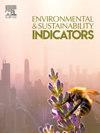Assessment of future urban flood risk of Thailand's bangkok metropolis using geoprocessing and machine learning algorithm
IF 5.4
Q1 ENVIRONMENTAL SCIENCES
引用次数: 0
Abstract
Thailand's capital Bangkok is no stranger to floods and the disruption caused by repetitive flooding. Rapid urbanization, inadequate infrastructure, and climate change exacerbate the situation as urban flooding becomes increasingly more frequent and severe. The aim of this study is to assess future urban flood risk of Bangkok metropolitan at the district level for three future periods: 2033, 2043, and 2053. In the assessment of flood risk, the future values of six dynamic urban flood indicators are first projected using an integrative geoprocessing and random forest machine learning algorithm. The projected future indicator values are subsequently used to assess urban flood risk across Bangkok's 50 districts. The six dynamic indicators of urban flood risk are average monthly rainfall, wet days, vegetation cover, population density, flood waste, and anti-flood infrastructure. The findings indicate a steady increase in average monthly rainfall and wet days, highlighting the need for improved floodwater drainage systems and flood resilience. Ongoing urbanization and decreasing vegetation cover exacerbate flood risks. Densely populated areas remain highly susceptible to flooding, underscoring the significance of effective population and waste management strategies. This study also proposes three-timescale urban flood mitigation plans (10-, 20- and 30-year plans) to mitigate future urban flood risk, focusing on short-, medium-, and long-term measures. This research is the first to integrate geoprocessing with machine learning to enhance the prediction performance and accuracy of future urban flood risk projections.
求助全文
约1分钟内获得全文
求助全文
来源期刊

Environmental and Sustainability Indicators
Environmental Science-Environmental Science (miscellaneous)
CiteScore
7.80
自引率
2.30%
发文量
49
审稿时长
57 days
 求助内容:
求助内容: 应助结果提醒方式:
应助结果提醒方式:


